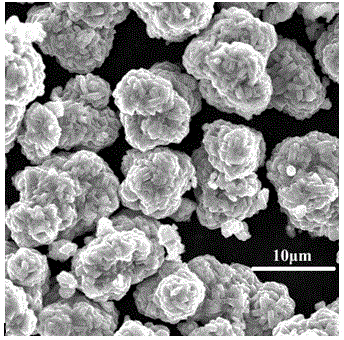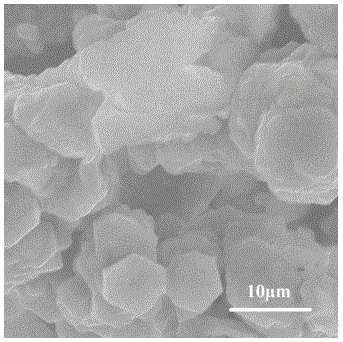A process for preparing lithium nickel manganese oxide by reverse recycling waste lithium batteries as raw materials
A technology for waste lithium batteries and lithium nickel manganese oxide, which is applied in battery recycling, recycling by waste collectors, battery electrodes, etc., can solve problems such as not being environmentally friendly, increasing wastewater treatment costs, and large separation potentials, so as to save costs and realize The effect of resource utilization and reduction of processing costs
- Summary
- Abstract
- Description
- Claims
- Application Information
AI Technical Summary
Problems solved by technology
Method used
Image
Examples
Embodiment 1
[0034] (1) The battery cell was disassembled, and the positive electrode sheet was taken out; the positive electrode sheet was pulverized, pyrolyzed, and sieved with a 60-mesh standard sieve under vibration to obtain 1846 g of positive electrode powder.
[0035] (2) Dissolve the positive electrode powder in 10L of nitric acid, remove the insoluble matter by filtration, control the pH of the filtrate to 2, add 20L of extractant, and the component of the extractant is P with a volume fraction of 30%. 2 0 4 And the sulfonated kerosene whose volume fraction is 70%, the equilibrium time is 15min, then back extraction with 10L2mol / L nitric acid, the equilibrium time is 15min, the obtained solution is a mixed solution of nickel nitrate and manganese nitrate, and the nickel ion concentration in the solution is measured as 0.60mol / L, manganese ion concentration is 0.63mol / L.
[0036] (3) Add 54.84g of nickel nitrate to the mixed solution in step (2), so that the concentration ratio of...
Embodiment 2
[0042] (1) Disassemble the battery cell and take out the positive electrode sheet; crush the positive electrode sheet, pyrolyze it, and sieve it with a 60-mesh standard sieve under vibration to obtain 1950 g of positive electrode powder.
[0043] (2) Dissolve the positive electrode powder in 10L of hydrochloric acid, remove the insoluble matter by filtration, control the pH of the filtrate to 2, add 20L of extractant, the components of the extractant are P204 with a volume fraction of 30% and sulfonated with a volume fraction of 70%. Kerosene, the equilibrium time is 20min, back extraction with 10L2mol / L hydrochloric acid, the equilibrium time is 20min, the obtained solution is a mixed solution of nickel chloride and manganese chloride, the nickel ion concentration in the solution is 1.25mol / L, and the manganese ion The concentration is 2.2mol / L.
[0044] (3) Add 390g of manganese chloride to the mixed solution in step (2), so that the concentration ratio of nickel ions to manga...
Embodiment 3
[0050] (1) The battery cell was disassembled, and the positive electrode sheet was taken out; the positive electrode sheet was crushed, pyrolyzed, and sieved with a 60-mesh standard sieve under vibration to obtain 1872 g of positive electrode powder.
[0051] (2) Dissolve the positive electrode powder in 10L of sulfuric acid, remove the insoluble matter by filtration, control the pH of the filtrate to 3, add 20L of extractant, the components of the extractant are P204 with a volume fraction of 30% and sulfonate with a volume fraction of 70%. Kerosene, equilibrium time is 30min, back extraction with 10L2mol / L sulfuric acid again, equilibrium time is 30min, obtains solution and is the mixed solution of nickel sulfate and manganese sulfate, records the nickel ion concentration in the solution and is 1.2mol / L, manganese ion concentration is 1mol / L.
[0052] (3) Add 1240g of nickel sulfate to the mixed solution in step (2), so that the concentration ratio of nickel ions to manganes...
PUM
 Login to View More
Login to View More Abstract
Description
Claims
Application Information
 Login to View More
Login to View More - R&D
- Intellectual Property
- Life Sciences
- Materials
- Tech Scout
- Unparalleled Data Quality
- Higher Quality Content
- 60% Fewer Hallucinations
Browse by: Latest US Patents, China's latest patents, Technical Efficacy Thesaurus, Application Domain, Technology Topic, Popular Technical Reports.
© 2025 PatSnap. All rights reserved.Legal|Privacy policy|Modern Slavery Act Transparency Statement|Sitemap|About US| Contact US: help@patsnap.com



